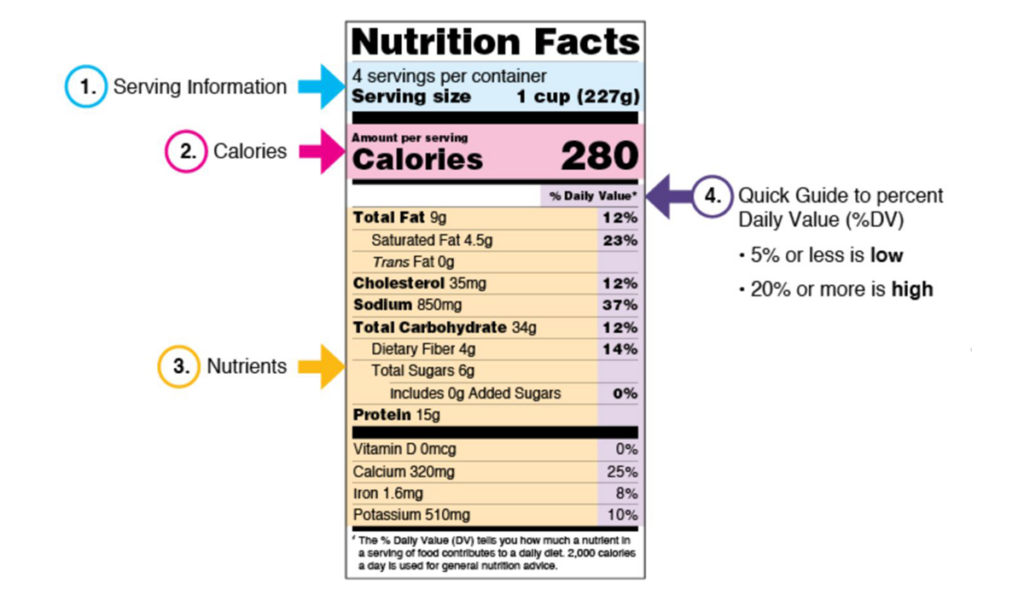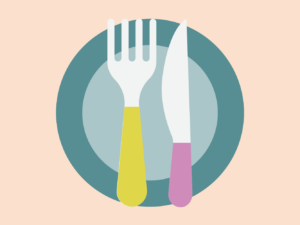Healthy Eating
Overview
Overview
A healthy, balanced diet is important to maintain a healthy weight, potentially improve your symptoms, and keep your heart from getting worse. Certain foods and the amount of fluids you drink may affect your condition or interact with your medication. That’s why it’s important that we spend time looking at some changes you can make to your diet to keep you and your heart healthy. For one, you should avoid sugary drinks, especially while exercising.
Most importantly, be mindful of your eating habits. Eating nutritious foods in healthy portion sizes is very important for heart health.
Scroll down to explore how you can practice mindful eating.
-
Nutrition
-
Portion Control
Nutrition
Mindful eating is knowing what you’re eating and how much. Here are some ways to be more mindful as you eat:
- Nutrition Facts: The nutrition labels on your food can tell you a lot about what you’re eating. Learning to read these labels can help you avoid excess sugar, fat, salt, and calories in your diet. The example nutrition label (below) shows you more about what you can learn when you take a closer look.
- Eat healthier foods: Did you know that more natural foods are found around the outside edge of the grocery store? That means the processed foods are in the center aisles. Try spending more time shopping around the outside edge. This can help you get more natural grains, fruits, and vegetables in your diet.
- Drink healthier: Choose water, skim milk / milk alternative, or seltzer water instead of sugary drinks.
- Eat less sugar: Eat food with 5 grams or less of added sugar per serving.
- Avoid trans fats: Avoid foods with trans fat, like hydrogenated oil or partially hydrogenated oil. When cooking, use canola oil or olive oil.
- Plan meals ahead: Planning your meals ahead of time can help you make better choices. You can even try using an app or website for ideas and shopping lists that can help you plan.
- Avoid eating out: Try to eat at restaurants as little as possible. If you do eat out, take some home. Restaurant portion sizes are often larger than the healthy recommendations. That means you’re eating more sugar, salt, fat, and calories than you should in a healthy meal.

Portion Control
 Focusing on portion control is an important part of mindful eating. Let’s look at some ways we can manage our portions:
Focusing on portion control is an important part of mindful eating. Let’s look at some ways we can manage our portions:
- Watch serving size: A serving size is the amount of food listed on the “Nutrition Facts” label. Some foods come in more than one serving, like candy bars and bags of chips. Looking at the nutrition label can help you make sure you only eat one serving at a time.
- Watch portion size: A portion size is the amount you actually choose to eat. Try to stick closely to the serving size.
- Measure your portions: Portions can be measured with spoons and cups or estimated with familiar objects. For example, a good portion of whole grain cereal is the size of your fist.
- Eat from a plate: One way to make sure you stick to the serving size is to eat from a plate instead of from the package.
- Drink between bites: Taking a drink between bites can help you slow down while you eat and help you control portion size.
- Eat slowly: Eating slowly means your body can tell you when you’re full before you’ve eaten too much. After eating a portion, rest for a few minutes. If you feel full, you really don’t need any more.
- Eat 3 meals a day: Try to stick to 3 meals a day plus one snack if you feel hungry.
Remember, food is fuel for an active body. Get up and move throughout the day, even for small activities or short walks.
Nutrition
Mindful eating is knowing what you’re eating and how much. Here are some ways to be more mindful as you eat:
- Nutrition Facts: The nutrition labels on your food can tell you a lot about what you’re eating. Learning to read these labels can help you avoid excess sugar, fat, salt, and calories in your diet. The example nutrition label (below) shows you more about what you can learn when you take a closer look.
- Eat healthier foods: Did you know that more natural foods are found around the outside edge of the grocery store? That means the processed foods are in the center aisles. Try spending more time shopping around the outside edge. This can help you get more natural grains, fruits, and vegetables in your diet.
- Drink healthier: Choose water, skim milk / milk alternative, or seltzer water instead of sugary drinks.
- Eat less sugar: Eat food with 5 grams or less of added sugar per serving.
- Avoid trans fats: Avoid foods with trans fat, like hydrogenated oil or partially hydrogenated oil. When cooking, use canola oil or olive oil.
- Plan meals ahead: Planning your meals ahead of time can help you make better choices. You can even try using an app or website for ideas and shopping lists that can help you plan.
- Avoid eating out: Try to eat at restaurants as little as possible. If you do eat out, take some home. Restaurant portion sizes are often larger than the healthy recommendations. That means you’re eating more sugar, salt, fat, and calories than you should in a healthy meal.

Portion Control
 Focusing on portion control is an important part of mindful eating. Let’s look at some ways we can manage our portions:
Focusing on portion control is an important part of mindful eating. Let’s look at some ways we can manage our portions:
- Watch serving size: A serving size is the amount of food listed on the “Nutrition Facts” label. Some foods come in more than one serving, like candy bars and bags of chips. Looking at the nutrition label can help you make sure you only eat one serving at a time.
- Watch portion size: A portion size is the amount you actually choose to eat. Try to stick closely to the serving size.
- Measure your portions: Portions can be measured with spoons and cups or estimated with familiar objects. For example, a good portion of whole grain cereal is the size of your fist.
- Eat from a plate: One way to make sure you stick to the serving size is to eat from a plate instead of from the package.
- Drink between bites: Taking a drink between bites can help you slow down while you eat and help you control portion size.
- Eat slowly: Eating slowly means your body can tell you when you’re full before you’ve eaten too much. After eating a portion, rest for a few minutes. If you feel full, you really don’t need any more.
- Eat 3 meals a day: Try to stick to 3 meals a day plus one snack if you feel hungry.
Remember, food is fuel for an active body. Get up and move throughout the day, even for small activities or short walks.
